Secessionism in Western Australia
Secessionism has been a recurring feature of Western Australia's political landscape since shortly after Federation in 1901. The idea of self-governance or secession has often been discussed through local newspaper articles and editorials. On a number of occasions secession has been a serious political issue for the State, including in a successful but unimplemented 1933 State referendum.
.svg.png.webp)
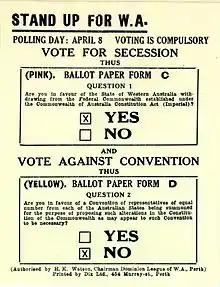
An argument in favour of secession is based on the assumption that a federal government in Canberra will favour the business and popular interests of the larger population centres. A common complaint is that Western Australia is a forgotten or Cinderella State, which contributes more to federal funds than it gets back, and is discriminated against by the more populous states.[1][2][3] The Constitution of Australia, however, describes the union as "one indissoluble Federal Commonwealth"[4] and makes no provision for states to secede from the union.
Colonial self-government
Petitions asking for representative elections for some of the positions in the Western Australian Legislative Council were presented to London in 1865 and 1869. This was granted in 1870 but maintained a Governor's veto.
In 1887 a new constitution including the right of self-governance was drafted and in 1890, the Act granting self-government was passed by the British House of Commons and assented to by Queen Victoria.
"Auralia" goldfields separation movement
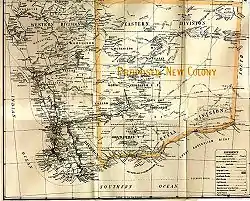
During the late 19th century, the WA government (like that of New Zealand) was reluctant to commit to the proposed Federation of British colonies in Australasia, and was lobbied by Federation committees from WA and the other colonies. This changed little with the granting of self-government to WA in 1889 – and the election of the Colony's first Premier John Forrest – which meant virtual independence from Britain, in all matters except defence, foreign affairs and trade. After the discovery of gold at Coolgardie (1892) and Kalgoorlie (1893), these towns were at the centre of the "Eastern Goldfields", and the flow of immigrants from the Eastern Colonies increased.
Tensions emerged during the mid-1890s between the Goldfields and the capital city. There were three main reasons for this:
- the extremely rapid growth of the Goldfields meant that its population soon rivalled that of the Perth metropolitan area;
- before the opening of the Perth-Kalgoorlie railway and Fremantle Harbour (both in 1897), Goldfields residents interacted relatively little with the metropolitan area (i.e. people moving from the Eastern Colonies to the Goldfields usually passed through the deep water port of Albany, took trains to Broomehill and then travelled by horse or on foot along Holland's Track to Coolgardie);
- Forrest's government favoured large mining companies over individual prospectors, antagonising many people in the Goldfields and;
- many Goldfields residents, due to their ties with the Eastern Colonies, strongly supported Federation.
In 1899, after several years of lobbying, the Eastern Goldfields Reform League compiled a Petition to Her Majesty the Queen from persons residing on the Goldfields, together with a refutation of the statements made in the petition, by Sir John Forrest.[5] It argued the case for the Goldfields' separation from Western Australia and the formation of a new Colony/State in the Goldfields, named "Auralia". In early 1900, Walter Griffiths travelled to London on behalf of the Eastern Goldfields Reform League executive, to present the petition to the British government and lobby the Colonial Office to either approve Auralia's separation, or force Western Australia to accept Federation. However, in spite of many requests by Griffiths, the Colonial Secretary, Joseph Chamberlain refused to meet him.
Nevertheless, the petition put pressure for the Western Australian government to join Federation.[6] Forrest led a push to include recent immigrants from the east on the electoral roll, ensuring that the referendum would pass. From 1 January 1901, when WA formally joined the other Colonies in federating as States of the Commonwealth of Australia, the impetus for creation of Auralia waned.
Federation
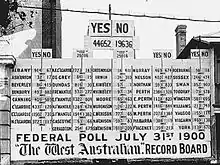
In 1900, Western Australians voted in a referendum to consider the draft Australian Constitution of the proposed Federation of Australia.[7] The result of the vote was 44,800 in favour and 19,691 against. Most country electorates voted 'No', except Albany and the Goldfields, which voted 'Yes'.
The Constitution, which came into force on 1 January 1901 states in its opening preamble:[8]
WHEREAS the people of New South Wales, Victoria, South Australia, Queensland, and Tasmania, humbly relying on the blessing of Almighty God, have agreed to unite in one indissoluble Federal Commonwealth under the Crown of the United Kingdom of Great Britain and Ireland, and under the Constitution hereby established. And whereas it is expedient to provide for the admission into the Commonwealth of other Australasian Colonies and possessions of the Queen ... [emphasis added]
Western Australia was not specifically mentioned in the preamble as its support was given too late for the document to be redrafted.
1933 referendum
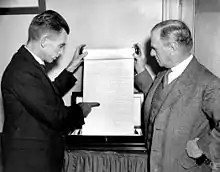
James MacCallum Smith, the proprietor of the local weekly newspaper, The Sunday Times started publishing pro-secessionist articles in 1907 under its editor Alfred T. Chandler. In 1926, Smith, a committed secessionist, and others established the Secession League to provide a public vehicle for advancing the secession cause. Prior to the Great Depression in 1930, the State's major export had been wheat. However, with the depression, wheat prices plummeted and unemployment in Perth reached 30%, creating economic havoc. Also in 1930, Keith Watson founded the Dominion League which advocated secession and the creation of a separate Dominion of Western Australia. The league held numerous rallies and public meetings which tapped into the general discontent brought on by the depression. Smith continued to agitate until the mid-1930s when a syndicate of mainly nationalists purchased the paper's parent company.
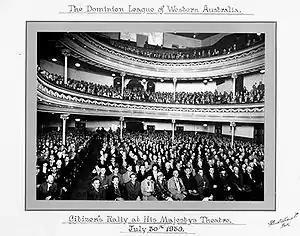
To counter the pro-secession movement, a Federal League of Western Australia was formed which organised a 'No' campaign. They brought several high-profile people to Western Australia including the Prime Minister Joseph Lyons, Senator George Pearce, and former Prime Minister Billy Hughes for a brief speaking tour of Perth, Fremantle and country centres, but often received hostile receptions. The Federalists argued for a constitutional convention to examine the state's grievances but was unable to counter the grassroots campaign of the Dominion League. The question of holding a constitutional convention was the second question asked in the referendum.
On 8 April 1933, Nationalist Premier Sir James Mitchell's government held a referendum on secession alongside the State parliamentary election. The Nationalists had campaigned in favour of secession while the Labor party had campaigned against breaking from the Federation. 68% of the 237,198 voters voted in favour of secession, but at the same time the Nationalists were voted out of office. Only the mining areas, populated by keen Federalists, voted against the move.
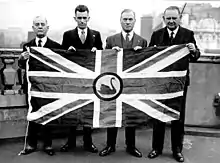
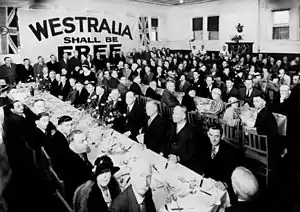
The new Labor government of Philip Collier sent a delegation to London with the referendum result to petition the British government to effectively overturn the previous Act of Parliament which had allowed for the creation of the Australian Federation. The delegation included the Agent General, Sir Hal Colebatch, Matthew Lewis Moss, James MacCallum Smith, and Keith Watson. They argued as follows:
Our opponents lay great stress on the words contained in the preamble to the Commonwealth of Australia Constitution Act:
- Have agreed to unite in one indissoluble Federal Commonwealth under the Crown of the United Kingdom of Great Britain and Ireland and under the Constitution hereby established.
They emphasise the word "indissoluble". We insist on the equal importance of the rest of the section: "Under the Crown" and "under this Constitution". Will it be contended that if – a highly improbable suggestion – the always loyal Commonwealth of Australia decided to break away from the British Crown and establish a republic, we in Western Australia should still be bound in the "indissoluble Federal Commonwealth?
Our contention is that the words "under the Constitution hereby established" are of equal significance, and if we can demonstrate – as we are prepared to do – that in a number of essentials, the Constitution has been violated to our detriment, we are entitled to be relieved from our bargain. The federation is a partnership between six States in which certain guarantees were given and certain safeguards were provided. We can show that these guarantees have been violated – that these safeguards have been swept aside – and so we ask for the annulment of the partnership.
After all, what does the word "indissoluble" mean? Remember that it occurs only in the preamble and not in the Act itself. Is any arrangement made in this world indissoluble? Can the rulers of any country 'dressed in a little brief authority', bind the people of that country not merely to the third and fourth generation, but for all time? Is there either justice or common sense in continuing an agreement that is working badly? Is a party to that agreement – after giving it a trial for 35 years and having proved it to be hampering to its industries, destructive to its prosperity and a grave bar to its development – prohibited from seeking relief?[9]
The United Kingdom House of Commons established a select committee to consider the issue but after 18 months of negotiations and lobbying, it finally refused to consider the matter, further declaring that it could not legally grant secession. The delegation returned home empty-handed.
As a consequence of the failure of negotiations and of the economic revival, the Secession League gradually lost support and by 1938 had ceased to exist.
80th anniversary
In April 2013, The West Australian newspaper and Western Australian State Records Office[10] celebrated the 1933 events with material to explain the issues.[11][12]
1974 Westralian Secession Movement
Iron ore magnate Lang Hancock founded the Westralian Secession Movement in 1974. His group focused largely on taxes and tariffs, arguing that trade barriers around Australia harmed the State's mainly mining and wheat export industries which earned a disproportionate amount of Australia's foreign exchange. In the 1974 Senate election, the party fielded Don Thomas as an ultimately unsuccessful candidate.
The Western Australian economy was, however, in an upswing at the time with major capital works underway and prosperity at an all-time high. The movement stagnated after a few years.
2000s considerations
| % of Australian total | |
|---|---|
| Population | 10.3% |
| Gross domestic product | 13.1% |
| Mineral and energy output | 48% |
| Merchandise exports | 39% |
| Exploration | 55% |
| Private investment | 28% |
| Share of GST | 8.1% |
At the start of the 21st century, Australia was in the middle of a "resources boom", which once again meant that Western Australia's economic contribution to the Australian economy was at a high point. Perceptions of a disproportionately low share of federal resources relative to economic contribution fanned a further wave of secessionist-leaning rhetoric. For example, at the 22 October 2008 Vista Public Lecture, former Western Australian Premier, Richard Court, said that the case for a secessionist movement is only strengthened while the Commonwealth government continues to exploit the State's resource-rich economy and fails to share the prosperity evenly.[14] He argued that, at the time, Western Australia accounted for 35% of the nation's export income yet most of the revenue is used to strengthen the "financial muscle growing in Canberra". The state has approximately 9–10% of the nation's population, generates over 10% of the Goods and Services Tax revenue, but received only 6% of what was being distributed. Court said that if the then-current Federation path continues, then by the year 2020, Western Australia would be receiving only 5% of what would be distributed by the Commonwealth Grants Commission. The former Premier said he was not advocating secession but stressed that the financial imbalance required addressing and that "the time to do so is now".
In July 2011, the Western Australian Minister for Mines and Petroleum, Norman Moore, made the controversial statement that WA should secede and rely on China and the United States for military defence to remain an independent nation free from Canberra's influence. Members of the Liberal Party responded to his comments negatively, stating that they were his personal view and not the stance of the Liberal Party.[15]
Western Australia was grouped with Scotland, Wales, the Basque Country, and Catalonia as "places seeking maximum fiscal and policy autonomy from their national capitals" in an October 2013 opinion piece in The New York Times.[16]
2017 Secessionist movement and COVID hard border
Following discussions within Parliament, and a successful motion at the 2017 Liberal Party State Conference, a new non-partisan Western Australian Secession Movement was founded.[17] The group was inspired by the disproportionate returns on GST payments. It was also due to a perceived lack of representation by the Federal Government, and the decision to withdraw the Western Force from Super Rugby.
The movement established formally with a social media presence at the start of September 2017.[18]
In June 2020 four activists from the "New Westralia" secessionist movement broke into the historic courthouse in York and were arrested soon after.[19]
Support for WA secession grew again during the COVID-19 Pandemic and WA's hard border closure with the rest of Australia in 2020.[20] A poll run in October 2020 found that 28% of Western Australians support Western Australia leaving the Australian federation.[21] During the same month, the pro-secessionist WAxit Party was formed.[22][23]
References
Citations
- Western Australia : the Cinderella state of the Commonwealth, Barclay & Sharland, 1920, retrieved 9 April 2013
- http://pandora.nla.gov.au/pan/95993/20100320-2137/www.wanowandthen.com/cinderella.html
- Thomas, Athol (10 October 1978), "Sunshine and space make the Cinderella State an exciting place", The Bulletin, Sydney (10 Oct 1978): 65–67+, ISSN 0007-4039
- The Attorney-General's Department. "Preamble to the Australian Constitution". Archived from the original on 10 May 2006. Retrieved 21 April 2006.
- "Auralia". Library and Information Service of Western Australia. Retrieved 14 August 2006.
- "Separation movement on the Eastern Goldfields, 1894–1904". Journal and Proceedings Western Australian Historical Society 1949. 4 (pt 5): 41–58. 1953.
- Musgrave, Thomas (2003). "The Western Australian Secessionist Movement" (PDF). Macquarie Law Journal. 3: 98. Retrieved 12 October 2009.
- The Attorney-General's Department. "Preamble to the Australian Constitution". Archived from the original on 10 May 2006. Retrieved 21 April 2006.
- Library and Information Service of Western Australia. "Secession 1929–1939: London". Retrieved 2 May 2006.
- http://www.sro.wa.gov.au/blogs/westralia-shall-be-free-western-australian-secession-referendum-1933
- http://www.slwa.wa.gov.au/federation/sec/063_sece.htm
- http://www.waec.wa.gov.au/elections/state_referendums/referendum_results/1933%20-%20Secession%20Referendum/
- "Resisting Canberra's centralist push". WA Business News. 6 May 2010. p. 36.
- Phillips, Yasmine. "Share the wealth or secession push will grow: Court". The West Australian 23 October 2008: 7.
- Lloyd Jones, 13 July 2011, WA minister blasted over secession remarks, Sydney Morning Herald
- Parag Khanna (2013). "The End of the Nation-State?" – The New York Times. Published 14 October 2013. Retrieved 26 November 2013.
- "Liberals back watered-down WAxit motion". ABC News. 3 September 2017. Retrieved 6 September 2017.
- "Western Australian Secessionist Movement". web.facebook.com. Retrieved 6 September 2017.
- Hedley, Kate (5 June 2020). "Bizarre scenes in tiny WA town as 'sovereign nation' attempts to overthrow government". WAtoday. Retrieved 5 June 2020.
- "Why WA wants to break off from the rest of Australia". 7NEWS.com.au. 6 October 2020. Retrieved 22 November 2020.
- "'Deeply concerning': One-in-four want WAxit". The West Australian. 5 October 2020.
- "How viable is a WA secession?". ABC Radio. 7 October 2020. Retrieved 8 October 2020.
- "Ex-Palmer pollies behind WAxit election push". The West Australian. 6 October 2020. Retrieved 8 October 2020.
Sources
- "1925 to 1950: From Federation to Thoughts on Secession". Archived from the original on 5 April 2006. Retrieved 20 April 2006.
- "Western Australia and Federation". Retrieved 20 April 2006.
Further reading
- http://www.liswa.wa.gov.au/federation/000_bibl.htm A collection of primary sources relating to secession at the J S Battye Library
- http://www.liswa.wa.gov.au/federation/iss/index.htm
- http://www.law.mq.edu.au/html/MqLJ/Volume3/Vol3_Musgrave.pdf
- http://www.fergco.com/~samgriffith/papers/html/volume3/v3chap5.htm – Geoffrey Bolton
- http://www.fergco.com/~samgriffith/papers/html/volume3/v3chap6.htm – Campbell Sharman
- http://www.curriculum.edu.au/ddunits/units/ms4fq3acts.htm#4act2
- Stateline – Norman Moore talks secession